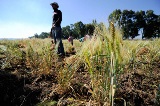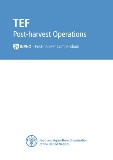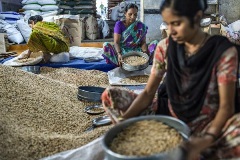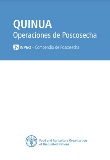Food Loss Related News
Food Loss Related Publications

Onion: Post-Harvest Operations
28/08/2003
Onion is an important crop worldwide. It is grown in both tropical and temperate regions at all scales of production. Improving post-harvest techniques in small and medium farming can particularly enhance efficiency and quality. If dried and packed properly, the bulbs can be stored and transported for considerable distances without deteriorating.

Barley: Post-Harvest Operations
15/06/2003
Barley is grown in about 70 million hectares in the world. Global production is 160 million tons. Developing countries accounts for about 18 % (26 million tons) of total barley production and 25 % (18.5 million hectares) of the total harvested area in the world.

Soybean: Post-Harvest Operations
06/07/2002
Soybean is a useful oil and protein source and can be used to improve the nutritional value of traditional foods. The beans are processed to give soy flour, meal or milk products and the oil can be extracted leaving a meal which is used for animal feed.

Groundnut | Post-harvest operations
07/06/2002
Groundnut is rich in oil and protein and has a high-energy value. The largest producers are China, India, Nigeria and the United States of America, but many other African and South American countries also have sizeable production. Groundnut provides high-quality cooking oil and is an important source of protein for both human and animal diets.

Mango: Post-Harvest Operations
02/06/2002
Mango is an important fruit for inhabitants of the tropics, with India being the largest producer. The trees require a frost-free tropical or sub-tropical climate, are 10 to 40 m in height and evergreen. The fruit is produced seasonally and eaten fresh or used in various recipes. In recent years, mangoes have become well established as fresh fruit and processed products in the global market.

Maize: Post-harvest Operations
15/05/2002
Maize is widely grown throughout the world and has the highest production of all the cereals with 817 million tonnes being produced in 2009 (FAOSTAT). It is an important food staple in many countries, as well as being used in animal feed and many industrial applications. The crop has tremendous genetic variability, which enables it to thrive in tropical, subtropical, and temperate climates.

Status of the postharvest sector and its contribution to agricultural development and economic growth
01/01/2002
JIRCAS international symposium | The past 35 years have witnessed an evolution of priorities within the postharvest sector of developing countries from a primarily technical focus geared toward the reduction of losses, to a more holistic approach designed to link on-farm activities to processing, marketing and distribution.

Potato | Post-harvest operations
17/05/2001
Potato is an important staple food world-wide, claiming fourth place after maize, rice and wheat. It is a good carbohydrate source in addition to other nutritional benefits. Potatoes are cooked before consumption which reduces the presence of the toxic alkaloid solanine. Developing countries now produce approximately one third of world production, which was 314 million tonnes in 2008 (FAOSTAT).

Teff: Post-Harvest Operations
14/05/2001
Teff is a staple crop in Eritrea and Ethiopia where it is a native annual grass species but is not widely known around the world. The very small seeds are cooked or fermented and have good nutritional content. The plant is very adaptable to different conditions but is day length sensitive, requiring 12 hours of daylight to flower.

Millet: Post-harvest operations
04/05/2001
Millet is a collective term referring to a number of small-seeded annual grasses that are cultivated as grain crops, primarily on marginal lands in dry areas of temperate, sub-tropical and tropical regions. It is regarded as a subsistence grain grown for food and animal fodder. The largest production is in India and Nigeria. Total world production in 2007 was 31 million tonnes (FAOSTAT).

Turmeric | Post-harvest operations
22/04/2001
Turmeric is a rhizome of a perennial herbaceous plant native to South Asia which requires a tropical climate. Southern India is the world’s largest producer. It can be used fresh or dried and ground to a fine powder. It imparts a distinctive flavour but it is also used to provide food with a deep, orange colour. It is an important ingredient in the curry dishes and cuisine of South Asia.

Wheat: Post-Harvest Operations
14/10/1999
Wheat is widely grown around the world under diverse climatic conditions and has been the staple food of the major civilizations in Europe, Asia and North Africa for 8,000 years. As an important staple food used in a wide variety of products, post-production operations play an important role in creating a stable food supply. Wheat is also used to produce animal feedstuffs, starch and ethanol.

Plantain: Post-Harvest Operations
14/10/1999
Plantain is a staple food and major source of carbohydrates for millions of people in Africa, Asia, the Caribbean, Latin America, and the Pacific. The fruit is predominantly used for human consumption and is generally cooked by boiling or frying when mature (green) or ripened. There is great potential for the crop in improved production methods and post-harvest techniques.

Rice: Post-Harvest Operations
14/10/1999
Rice is a staple food for over half the world's people and has the second largest cereal production after maize with over 685 million tonnes recorded in 2008 (FAOSTAT). China, India, Indonesia and Pakistan are the biggest producers. Rice cultivation requires more water than other cereals and is more labour intensive.

Sorghum: Post-Harvest Operation
14/10/1999
Sorghum is the fifth most important cereal grown with a world production of over 55 million tonnes in 2008 (FAOSTAT). Most varieties are heat and drought tolerant, hence it is an important crop in arid areas. It is an important source of food in Africa, Central America, and South Asia and is also used to produce alcoholic beverages and biofuel.

Coconut | Post-harvest operations
14/10/1999
Coconut, the fruit from the coconut palm tree is widely grown throughout the tropics. The palm trees grow to 30 m and require a continuous frost-free warm climate, plenty of rain and sunlight. India, Indonesia and the Philippines are the largest producers. An adult palm tree will produce coconut fruits every month throughout the year. Young immature coconuts are harvested for coconut water, a nutritious drink, and mature fruits for the white ‘meat’ and oil.

Cassava | Post-harvest operations
14/10/1999
Cassava is an edible root that provides an important source of carbohydrates for an estimated 500 million people in Africa, Asia and the Americas. World production was 230 million tonnes in 2008, with Nigeria as the largest producer followed by Brazil, Thailand and Indonesia (FAOSTAT).

Phaseolus Bean | Post-harvest operations
14/10/1999
Phaseolus Bean or the common bean is the most important food legume for direct consumption in the world and is a major source of dietary protein in many developing countries. It is produced in a range of crop systems and environments in regions as diverse as Africa, Europe, Latin America, the Middle East and United States as well as Canada and China. The beans can be consumed by eating the fresh green pods but are more usually removed from the pods, dried and cooked.

Quinoa: Post-Harvest Operations
06/06/1997
Quinoa (Chenopodium quinoa Wild) is grown in arid and semi-arid areas of the Andes, but it is very adaptable and can be grown at sea level. Its cultivation has spread to more than 70 countries. Quinoa has a protein of high biological value with a high lysine content. It is used both in the human diet and as animal feed. The ripe grain is also consumed, directly or in a processed state.
